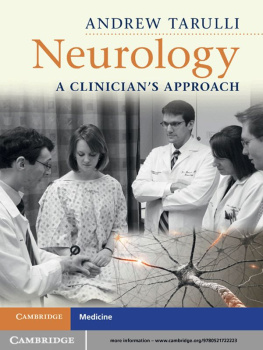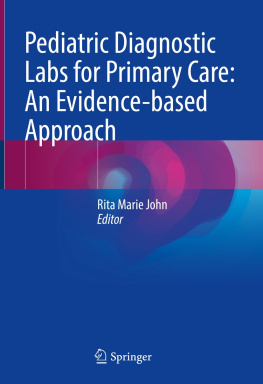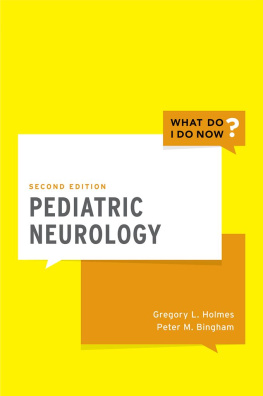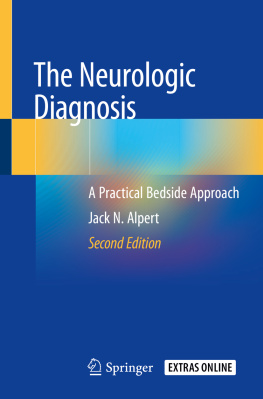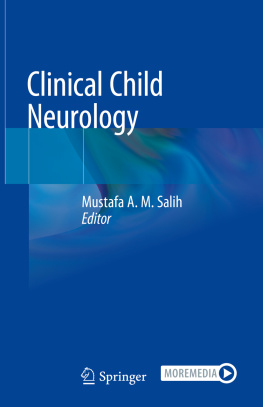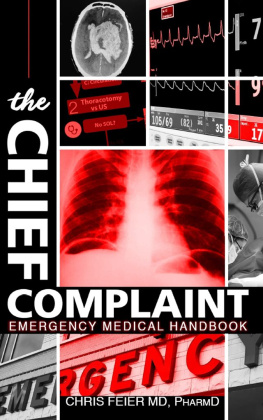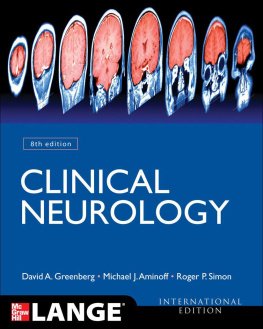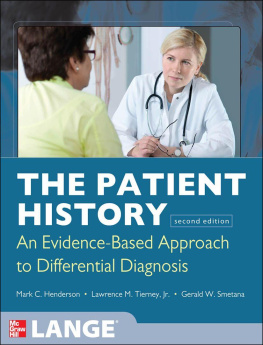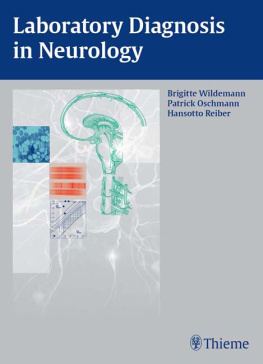CAMBRIDGE UNIVERSITY PRESS
Cambridge, New York, Melbourne, Madrid, Cape Town, Singapore, So Paulo, Delhi, Dubai, Tokyo, Mexico City
Cambridge University Press
The Edinburgh Building, Cambridge CB2 8RU, UK
Published in the United States of America by Cambridge University Press, New York
www.cambridge.org
Information on this title: www.cambridge.org/9780521722223
Cambridge University Press 2011
This publication is in copyright. Subject to statutory exception and to the provisions of relevant collective licensing agreements, no reproduction of any part may take place without the written permission of Cambridge University Press.
First published 2011
Printed in the United Kingdom at the University Press, Cambridge
A catalog record for this publication is available from the British Library
Library of Congress Cataloging in Publication data
Tarulli, Andrew.
Neurology : a clinicians approach / Andrew Tarulli.
p.; cm.
Includes bibliographical references and index.
ISBN 978-0-521-72222-3 (pbk.)
1. Nervous systemDiseasesDiagnosis. 2. Neurology. I. Title.
[DNLM: 1. Nervous System Diseasesdiagnosis. 2. Physical Examinationmethods. WL 141]
RC346.T27 2011
616.8dc22 2010034893
ISBN 978-0-521-72222-3 Paperback
Cambridge University Press has no responsibility for the persistence or accuracy of URLs for external or third-party internet websites referred to in this publication, and does not guarantee that any content on such websites is, or will remain, accurate or appropriate.
Every effort has been made in preparing this book to provide accurate and up-to-date information which is in accord with accepted standards and practice at the time of publication. Although case histories are drawn from actual cases, every effort has been made to disguise the identities of the individuals involved. Nevertheless, the authors, editors and publishers can make no warranties that the information contained herein is totally free from error, not least because clinical standards are constantly changing through research and regulation. The authors, editors and publishers therefore disclaim all liability for direct or consequential damages resulting from the use of material contained in this book. Readers are strongly advised to pay careful attention to information provided by the manufacturer of any drugs or equipment that they plan to use.
For my parents, Marianne and Joe Tarulli, and my brother, Matt.
Foreword
Although there are many good textbooks of neurology some of them extremely comprehensive and multivolume in type, some of them presented as tabulated texts none of them presents a basic clinical approach to the individual patient. When faced with an individual patient and an individual complaint, one must use deductive reasoning to come to a diagnosis. An accurate history leads the way and will more often than not provide the likely diagnosis. The history allows for a hypothesis, which must be tested by the clinical exam.
Dr. Tarulli has blazed a pathway from history through examination to diagnosis based on clinical acumen rather than on blind imaging searching for a possible diagnosis. Each chapter is in itself a pearl of information designed to teach the reader how to get from chief complaint to final diagnosis and then to consider further investigation when appropriate. Too often nowadays, there is a tendency to jump to technology without clearly thinking through a clinical problem, to the detriment of patient care and overutilization of expensive and sometimes unnecessary studies.
The book is written for advanced medical students and residents early in training and is a practical guide to patient care. It follows in the footsteps of classical clinical neurology and should prove invaluable to neurologists in training. These young doctors need a practical, symptom-based approach to patient care. This is the place to find it.
Michael Ronthal, MB BCh
Professor of Neurology
Harvard Medical School
Beth Israel Deaconess Medical Center
Boston, MA, USA
June 16, 2010
Preface
Does the world need another introductory neurology textbook? My initial answer was no, but after considerable and considerate prodding by my publishers, I relented and decided to write Neurology: A Clinicians Approach for two reasons.
First, I wrote it because it is the book that I sought as a senior medical student and junior neurology resident. Although there were many great books that organized neurology by specific disease processes, I wanted to learn how a neurologist approached a problem. The question for me was: how does a neurologist start with a patient who comes into their office with falls and end by making a diagnosis of progressive supranuclear palsy? The answer is that they know how to ask the right questions, interpret the patients answers, and perform a focused neurological examination that will lead them to the gold. This diagnostic process requires basic knowledge of anatomy and physiology, but immeasurably more experience with patients and recognition of both common and uncommon patterns of disease. The textbooks that I found sufficed on the anatomy and physiology fronts, but I needed the wisdom of my professors and some time to acquire the experience that would make me into a neurologist. My problem was that I was impatient and, try as I might, I could not find the wisdom I was looking for in any of the textbooks in the Countway Library of Medicine.
Secondly, it is derived from the series of case conferences that I lead on a twice-weekly basis with third-year Harvard medical students at Beth Israel Deaconess Medical Center. A student presents a case, and we begin, from the first sentence of their presentation, on a diagnostic journey that involves defining the problem, generating a list of possible anatomic localizations, discussing the utility of different tests, and considering treatments and their likely outcomes. These conferences are the highlights of my week: it gives me immense pleasure to help the students to connect the dots and put their universally impressive factual knowledge into clinical practice. My students have encouraged me to put my approach into writing, and the basic text of Neurology: A Clinicians Approach reflects our case conference format.
Each of the problems that face a neurologist requires a different approach. In general, however, the technique of Neurology: A Clinicians Approach is to start by defining the chief complaint, move to techniques concerning how to take the history and how to conduct a neurological examination relevant to the particular question, figure out which diagnostic tests to order, and then conclude with common disease processes and their management. Unlike introductory books, there is no single chapter dedicated to the neurological examination. Rather, I try to teach the examination as a tool to be used intelligently in order to reach a diagnosis. I have tried to limit redundancy through cross-referencing, but there is inevitably some overlap among the chief complaints. I have also tried to use the evidence as much as possible, but I am by no means a slave to it. Finally, I have addressed topics that are frequently ignored in other introductory neurology texts. There are discussions of fibromyalgia, Raynauds phenomenon, and conversion disorders, for example, which are common in clinical practice but often exist outside of the vacuum of neurological diseases presented to the newcomer to the field.

